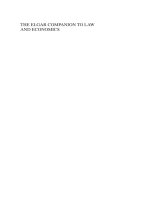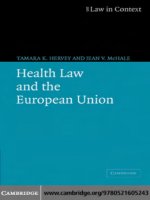Public Health Law and Ethics ppt
Bạn đang xem bản rút gọn của tài liệu. Xem và tải ngay bản đầy đủ của tài liệu tại đây (2.6 MB, 557 trang )
Public Health Law and Ethics
California/Milbank Books on Health and the Public
1. The Corporate Practice of Medicine: Competition and Innova-
tion in Health Care, by James C. Robinson
2. Experiencing Politics: A Legislator’s Stories of Government and
Health, by John E. McDonough
3. Public Health Law: Power, Duty, Restraint, by Lawrence O.
Gostin
4. Public Health Law and Ethics: A Reader, edited by Lawrence
O. Gostin
Public Health
Law and Ethics
A Reader
Edited by Lawrence O. Gostin
UNIVERSITY OF CALIFORNIA PRESS
Berkeley · Los Angeles · London
THE MILBANK MEMORIAL FUND
New York
University of California Press
Berkeley and Los Angeles, California
University of California Press, Ltd.
London, England
©2002 by Lawrence O. Gostin
Library of Congress Cataloging-in-Publication Data
Public health law and ethics : a reader / edited by
Lawrence O. Gostin.
p. cm.—(California/Milbank books on health and
the public)
Includes bibliographical references and index.
ISBN 0-520-23174-0 (alk. paper)—
ISBN 0-520-23175-9 (pbk. : alk. paper)
1. Public health laws —United States. 2. Public
health—Moral and ethical aspects. I.
Gostin, Larry O. (Larry Ogalthorpe) II. Series.
KF3775 .P83 2002
344.73'04 dc21 2001049172
Printed and bound in Canada
08 07 06 05 04 03 02
10 987654321
The paper used in this publication is both acid-free
and totally chlorine free (TCF). It meets the mini-
mum requirements of ANSI/NISO
Z39.48-1992(R 1997) (Permanence of Paper).
List of Illustrations xi
List of Tables xiii
A Reader in Public Health Law and Ethics: The Web Site xiv
Conventions Used in This Book xv
Foreword by Daniel M. Fox and Samuel L. Milbank xvii
Preface xix
1. Public Health Law, Ethics, and Human Rights:
Mapping the Issues 1
part one: foundations of public health
law and ethics
2. Public Health: The Population-Based Perspective 23
SOURCES: Lemuel Shattuck, Introduction and Private
Rights and Liberties / 25 · Elizabeth Fee, The Origins and
Development of Public Health in the United States / 27 ·
Institute of Medicine, The Functions of Public Health / 37
· Scott Burris, The Invisibility of Public Health: Population-
Level Measures in a Politics of Market Individualism / 41
· J. Michael McGinnis and William H. Foege, Actual
Causes of Death in the United States / 50 · Geoffrey Rose,
Sick Individuals and Sick Populations / 58
Contents
3. Public Health Ethics:
The Communitarian Tradition 67
SOURCES: Michael Walzer, Security and Welfare / 69 · Dan
Beauchamp, Community: The Neglected Tradition of Public
Health / 76 · Norman Daniels et al., Justice Is Good for Our
Health / 82
4. Human Rights and Public Health 95
SOURCES: George J. Annas, Human Rights and Health—The
Universal Declaration of Human Rights at 50 / 98 ·
Jonathan M. Mann et al., Health and Human Rights / 106 ·
Jonathan M. Mann, Medicine and Public Health, Ethics, and
Human Rights / 113 · Brigit Toebes, Towards an Improved
Understanding of the International Human Right to Health / 116
5. Reasoning in Public Health:
Philosophy, Risk, and Cost 127
SOURCES: Philip Cole, The Moral Bases for Public Health
Interventions / 130 · Supreme Court of Vermont, Benning v.
Vermont / 137 · Stephen Breyer, Breaking the Vicious Circle:
Towards Effective Risk Regulation / 140 · Cass R. Sunstein,
Health-Health Tradeoffs / 145 · Louise B. Russell, Cost-
Effectiveness Analysis / 151 · Kenneth J. Arrow et al., Is
There a Role for Benefit-Cost Analysis in Environmental,
Health, and Safety Regulation? / 153
part two: the law and the public’s health
6. Public Health Duties and Powers 161
SOURCES:Wendy Parmet, Health Care and the Constitution:
Public Health and the Role of the State in the Framing Era /
163 · Supreme Court of the United States, DeShaney v.
Winnebago County Department of Social Services / 170 ·
Supreme Court of the United States, South Dakota v. Dole /
179 · Supreme Court of the United States, United States v.
Lopez / 182 · William J. Novak, Governance, Police, and
American Liberal Mythology / 186 · Supreme Court of the
United States, New York v. United States / 193
7. Public Health and the Protection
of Individual Rights 203
SOURCES: Supreme Court of the United States, Jacobson v.
Massachusetts / 206 · Circuit Court, Northern District of
Contentsvi
California, Jew Ho v. Williamson / 217 · Supreme Court of
the United States, City of Cleburne v. Cleburne Living Center
/ 220 · Supreme Court of Appeals of West Virginia, Greene v.
Edwards / 224
8. Public Health Regulation of Property and the
Professions 229
SOURCES: Supreme Court of the United States, Food and
Drug Administration v. Brown & Williamson Tobacco Corp.
/ 234 · New York Court of Appeals, Boreali v. Axelrod / 241
· Supreme Court of the United States, Dent v. West Virginia /
244 · Supreme Court of the United States, Camara v.
Municipal Court / 248 · Supreme Court of New York, New
York v. New St. Mark’s Baths / 252 · Supreme Court of the
United States, Lochner v. New York / 254 · Supreme Court of
the United States, Lucas v. South Carolina Coastal Council /
258
9. Tort Litigation for the Public’s Health 265
SOURCES: Stephen P. Teret, Litigating for the Public Health /
268 · Wendy E. Parmet and Richard A. Daynard, The New
Public Health Litigation / 269 · Tom Christoffel and Stephen
P. Teret, Epidemiology and the Law: Courts and Confidence
Intervals / 276 · Supreme Court of the United States, Daubert
v. Merrell Dow Pharmaceuticals, Inc. / 281 · Peter W. Huber,
Galileo’s Revenge: Junk Science in the Courtroom / 287
part three: tensions and recurring themes
10. Surveillance and Public Health Research:
Privacy and the “Right to Know” 295
SOURCES: Ruth L. Berkelman et al., Infectious Disease
Surveillance: A Crumbling Foundation / 296 · Daniel M.
Fox, From TB to AIDS: Value Conflicts in Reporting Disease
/ 300 · Sandra Roush et al, Mandatory Reporting of Diseases
and Conditions by Health Care Providers and Laboratories /
304 · Supreme Court of the United States, Whalen v. Roe /
307 · Allan M. Brandt, Racism and Research: The Case of
the Tuskegee Syphilis Study / 312 · Ronald Bayer and
Kathleen E. Toomey, HIV Prevention and the Two Faces of
Partner Notification / 321 · Lawrence O. Gostin et al.,
Informational Privacy and the Public’s Health: The Model
State Public Health Privacy Act / 328
Contents vii
11. Health Promotion: Education,
Persuasion, and Free Expression 335
SOURCES: David R. Buchanan, Disquietudes / 339 · Ruth R.
Faden, Ethical Issues in Government-Sponsored Public
Health Campaigns / 346 · Supreme Court of the United
States, 44 Liquormart, Inc. v. Rhode Island / 357 · Supreme
Court of the United States, Lorillard Tobacco Co. v. Reilly /
364 · Court of Appeals for the Second Circuit, International
Dairy Foods Association v. Amestoy / 371
12. Biological Interventions to Control
Infectious Disease: Immunization,
Screening, and Treatment 377
SOURCES:Garrett Hardin, The Tragedy of the Commons /
383 · Supreme Court of the United States, Zucht v. King /
390 · Supreme Court of Mississippi, Brown v. Stone / 391 ·
Ruth R. Faden et al., Warrants for Screening Programs:
Public Health, Legal, and Ethical Frameworks / 395 ·
Supreme Court of the United States, Skinner v. Railway
Labor Executives’ Association / 399 · Supreme Court of the
United States, Ferguson v. City of Charleston / 404 · Ronald
Bayer and David Wilkinson, Directly Observed Therapy for
Tuberculosis: History of an Idea / 408
13. Restrictions of the Person: Civil
Confinement and Criminal Punishment 415
SOURCES: J.M. Eager, The Early History of Quarantine:
Origin of Sanitary Measures Directed against Yellow Fever /
417 · Supreme Court of South Carolina, Kirk v. Wyman /
421 · Supreme Court of Ohio, Ex parte Company / 424 ·
Supreme Court, Queens County, City of New York v.
Antoinette R. / 428 · Jennifer Frey, Nushawn’s Girls / 431 ·
Indiana Court of Appeals, State v. Haines / 436 · Court of
Appeals for the Fourth Circuit, United States v. Sturgis / 439
part four: the future of public health
14. Vision and Challenges: Case Studies on
Emerging Infections, Bioterrorism,
and Public Health Genetics 447
Contentsviii
SOURCES: Mary E. Wilson, Infectious Diseases: An
Ecological Perspective / 450 · Stuart B. Levy, Antibiotic
Availability and Use: Consequences to Man and His
Environment / 456 · Donald A. Henderson, The Looming
Threat of Bioterrorism / 463 · Centers for Disease Control
and Prevention, Biological and Chemical Terrorism: Strategic
Plan for Preparedness and Response / 468 · Muin J. Khoury
et al., Challenges in Communicating Genetics: A Public
Health Approach / 475 · Allen Buchanan et al., Two Models
for Genetic Intervention / 480
Bibliography 487
Table of Cases 509
Index 513
About the Author 523
Contents ix
List of Illustrations
PHOTOGRAPHS
1. Ten great public health achievements of the
twentieth century xxxii
2. The threat of infectious diseases from incoming vessels 22
3. Spinal tap performed as part of the Tuskegee syphilis study 66
4. Preparing a patient for irradiation at a cyclotron 94
5. Cuyahoga River in flames 126
6. Measures to combat the West Nile virus 160
7. National Youth Association march to encourage
syphilis testing 202
8. Painting at an exhibition featuring the public’s response
to mad cow disease 228
9. Ford Motor Co. executives at House Committee
investigation of Firestone tire recall 264
10. Tuskegee syphilis study victim receives formal apology
from President Clinton 294
11. Van Gogh, Skull of Skeleton with a Burning Cigarette 334
12. Vaccination of indigent persons in the community 376
13. A New York quarantine station of the late 1880s 414
14. Firefighters after cleaning subway cars contaminated by
toxic gas in Tokyo 446
15. Researcher examines biological agents in a maximum
containment virology lab 461
FIGURES
1. Determinants of health 5
2. The field of public health: alternative visions 7
3. Public health law: core concepts 9
4. Modern mission and essential functions of
public health agencies 36
5. Life expectancy and per capita GDP 85
List of Illustrations xii
6. Life expectancy and per capita GDP: advanced industrial
economies 85
7. Synergy between public health and human rights 97
8. The human right to health 98
9. Justifying public health regulation 128
10. Constitutional triangle 162
11. Constitutional functions 204
12. Public health agency functions 232
13. Tort law as a tool in public health 266
14. A governmental role in health promotion and education 336
15. “Can we really make the underage smoking problem
smaller by making the federal bureaucracy bigger?” 354
16. “Of cigarettes and science” 355
List of Tables
1. Public health 3
2. Public health ethics 11
3. Human rights 16
4. Goals and recommendations for public health’s
infrastructure 37
5. Ten leading causes of death by age group: 1997 48–49
6. School immunization laws among states 380–382
7. Time line of selected federal and state court decisions
regarding vaccination law and policy 387–389
8. Ten great public health achievements: United States,
1900–1999 448
9. Current and future public health challenges 448
10. Deadliest five biological agents 462
11. Laws to combat bioterrorism 471
12. Public health powers needed in a bioterrorism event 471
A READER IN PUBLIC HEALTH LAW AND ETHICS:
THE WEB SITE
To provide readers with the most comprehensive and timely informa-
tion possible, I have launched a companion web site to complement this
text. This site, which is integrated into the web site of the Center for
Law and the Public’s Health at Georgetown and Johns Hopkins Uni-
versities, is made possible with the generous support of the Milbank
Memorial Fund. The Reader web site is designed to greatly enhance
your reading experience and to provide an important resource for pub-
lic health law students, scholars, and practitioners.
Throughout this book, readers are referred to materials posted on
this site. The contents of the site are keyed to the chapters of the
Reader, and include
•
Full-text versions of selected court cases excerpted in the Reader
•
Selected articles and reports discussed or cited in the Reader
•
Recent public health law cases, statutes, regulations, and news up-
dates
•
Links to other sites of interest
Please visit the Reader web site at www.publichealthlaw.net/reader.
xv
Conventions Used
in This Book
The excerpted materials in the Reader have been edited for clarity and
reduced length. These edits have been made carefully so as not to com-
promise the meaning or substance of the readings. My intent is to
communicate the substance of the case or article, in the words of the
author(s), without interfering with its readability. The following editing
and other conventions have been used consistently throughout the
Reader.
The citation form for books and articles is taken from The Chicago
Manual of Style (14th ed.). The citation form for judicial cases is taken
from The Bluebook: A Uniform System of Citation (17th ed.). All orig-
inal references or notes in the excerpts have been deleted, except where
they support quotations. In these instances, the references have been
added to the bibliography and indicated within the text of the reading.
Headings and subheadings within articles or cases have been capital-
ized and italicized, respectively, regardless of how they appear in the
original text. Brackets ([ ]) are used in the readings to introduce my
own commentary or edits of the original excerpted material.
Omissions of text within articles and cases are indicated through the
use of ellipses (. . .) in accordance with the following rules: three peri-
ods (. . .) indicate an omission within a sentence and four periods (. . . .)
indicate an omission that includes a sentence break (and may consist of
part of a paragraph or several paragraphs). Five asterisks within the
text (* * * * *) indicate a break between the end of an article or case
and my own written commentary, except where this break is clear (e.g.,
the excerpt is followed by a major subject header).
The term “companion text” refers to my public health law book,
Public Health Law: Power, Duty, Restraint (New York: Milbank Me-
morial Fund and Berkeley: University of California Press, 2000). Refer-
ences to the “Reader web site” refer to the web site accessible at the
following address: www.publichealthlaw.net/reader. This regularly up-
dated web site offers supplemental information, cases, and updates to
the Reader text.
Concerning abbreviations, the first time an abbreviation is men-
tioned in a chapter, I have included the full name or term to which the
abbreviation pertains (e.g., Institute of Medicine [IOM]), unless the ab-
breviation is commonly known (e.g., AIDS). Each subsequent use of the
name or term in the text or excerpt utilizes the abbreviation.
I welcome comments from readers about the comprehensiveness,
readability, and clarity of the Reader. I would appreciate being in-
formed if I have omitted major articles or cases important to public
health law or ethics.
Conventions Used in This Book xvi
xvii
Foreword
The Milbank Memorial Fund is an endowed national foundation that
engages in nonpartisan analysis, study, research, and communication
on significant issues in health care and public health. The fund makes
available the results of its work in meetings with decision-makers, re-
ports, articles, and books.
The purpose of the Fund’s publishing partnership with the University of
California Press is to encourage the synthesis and communication of find-
ings from research and experience that could contribute to more effective
health policy. The two volumes by Lawrence O. Gostin published by the
Fund and the Press achieve this goal.
In 2000, the Fund and the Press published Gostin’s Public Health
Law: Power, Duty, Restraint. Reviewers of the manuscript of that book
suggested we also publish a reader that could be used independently or
as a companion to the first volume.
Gostin brings to both books vast experience as a lawyer and legal
scholar on public health issues. For many years, in both the United
Kingdom and the United States, Gostin has been a lawyer’s lawyer as
well as an adviser to policy makers on the most controversial issues in
public health law. This combination of scholarship and experience
leads Gostin to propose that public health law should be an instrument
for developing as well as implementing public policy. In Public Health
Law he offers a critical analysis and synthesis of law and science that
promises to improve the effectiveness of public policy in enhancing the
health of populations. The articles collected in this Reader and Gostin’s
commentary on them demonstrate the significance of law and the
analysis of it for effective health policy.
Daniel M. Fox
President
Samuel L. Milbank
Chairman
xviii Foreword
xix
Preface
The field of public health is typically regarded as a positivistic pursuit
and, undoubtedly, our understanding of the etiology and response to
disease is heavily influenced by scientific inquiry. Public health policies,
however, are shaped not only by science but also by ethical values, legal
norms, and political oversight. Public Health Law and Ethics: A Reader
offers a careful selection of government reports, scholarly articles, and
court cases designed to illuminate the ethical, legal, and political issues
in the theory and practice of public health.
Before examining law and ethics, it is helpful to explore the mean-
ing of public health. The excerpts and commentaries in the Reader offer
several alternative definitions of public health, but focus principally on
the Institute of Medicine’s (IOM) influential definition in The Future of
Public Health: “Public health is what we, as a society, do collectively to
assure the conditions for people to be healthy.”
The IOM definition emphasizes the collective responsibility of or-
ganized society to promote the health of the population. Despite the
richness of this definition, the IOM does not delineate the field’s legit-
imate scope within a representational democracy. Should public health
be confined to relatively discrete interventions to prevent immediate
causes of injury and disease—for example, surveillance, health educa-
tion, and infectious disease control? Alternatively, should public
health be concerned with larger social and economic problems that
play important, but not fully understood, roles in health and disease—
such as livable cities, adequate housing, violence prevention, and re-
duction in socioeconomic disparities? The Reader does not resolve the
tension between a narrow and a broad focus of public health, but it
does frame the question and suggests potential benefits and disadvan-
tages of each approach.
THE PUBLIC HEALTH LAW INFRASTRUCTURE
The field of public health is grounded in law and cannot function ef-
fectively without a strong legal infrastructure. Law establishes the
foundations for public health governance—for example, funding
mechanisms, administrative structures, and workforce. Law empow-
ers public health agencies to act, sets limits on those powers in order
to protect individual rights, and requires health authorities to follow
defined procedures. At the same time, law defines boundaries for ac-
ceptable behavior, both individual and organizational, and permits
the deprivation of liberty, autonomy, privacy, and property to safe-
guard the public’s health.
The IOM urged fundamental reform of state public health laws to
achieve two objectives: (1) clearly delineate the basic authority and re-
sponsibility entrusted to public health agencies, and (2) support a set of
modern disease control measures that address contemporary health
problems. The U.S. Department of Health and Human Services report
Healthy People 2010 similarly recognized the importance of public
health law: “The Nation’s public health infrastructure would be
strengthened if jurisdictions had a model law and could use it regularly
for improvements.”
The IOM and DHHS were concerned with a body of enabling
laws and regulations that are highly antiquated; many state laws
have not been significantly revised since the early twentieth century.
As a result, these laws have failed to keep pace with the remarkable
advances in public health sciences and constitutional doctrine. In-
deed, most of these laws do not conform with modern thinking about
the mission, core functions, and essential services of public health au-
thorities.
The public health community is actively seeking to strengthen the
public health law infrastructure. The IOM Board on Health Promo-
tion and Disease Prevention established a study committee to provide
xx Preface
Preface xxi
a vision for public health in the twenty-first century, including law re-
form. Just as important, the Robert Wood Johnson and Kellogg foun-
dations’ Turning Point project launched a “Public Health Statute
Modernization” initiative designed to write a comprehensive model
state public health law. For a Model Emergency Health Powers Act
written in response to the terrorist attacks on September 11, 2001, see
www.publichealthlaw.net.
Public health laws not only provide the foundations for public health
practice, but also provide a set of tools for public health authorities.
There are at least five models for legal intervention designed to prevent
injury and disease and promote the public’s health. Although legal in-
terventions can be effective, they often raise social, ethical, or constitu-
tional concerns that warrant careful study.
Model 1 is the power to tax and spend. This power, found in federal
and state constitutions, provides government with an important regu-
latory technique. The power to spend enables government to set condi-
tions for the receipt of public funds. For example, the federal govern-
ment grants highway funds to states on condition that they set the
drinking age at 21. The power to tax provides strong inducements to
engage in beneficial behavior or refrain from risk behavior. For exam-
ple, taxes on cigarettes significantly reduce smoking, particularly
among young people. The spending and taxing power, however, can be
seen as coercive and, in many cases, “sin” taxes are highly regressive.
Model 2 is the power to alter the informational environment. Gov-
ernment can add its voice to the marketplace of ideas through health
promotion activities such as health communication campaigns, provide
relevant consumer information through labeling requirements, and
limit harmful or misleading information through regulation of com-
mercial advertising of unsafe products (e.g., cigarettes and alcoholic
beverages). But even these interventions can be controversial. Not
everyone believes that public funds should be expended, or the veneer
of government legitimacy used, to prescribe particular social orthodox-
ies—unsafe sex, abortion, smoking, high-fat diet, or sedentary lifestyle,
for example. Labeling requirements seem unobjectionable, but busi-
nesses strongly protest compelled disclosure of certain kinds of infor-
mation. For example, should businesses be required to disclose that
foods have been genetically modified (GM) or that dairy cows have re-
ceived Bovine Growth Hormone (BGH)? GM foods and BGH have not
been shown to be dangerous to humans, but the public demands a
Preface
“right to know.” Advertising regulations restrict commercial speech,
thus implicating businesses’ First Amendment rights. Should govern-
ment be permitted to limit truthful information because it conveys ad-
venturesome, healthful, or sexual images about harmful products?
Model 3 is direct regulation of individuals (e.g., seatbelt and motor-
cycle helmet laws), professionals (e.g., licenses), or businesses (e.g., in-
spections and occupational safety standards). Public health authorities
regulate pervasively to reduce risks to the population. Most people rec-
ognize the value of public health regulation, but coercive government
action inevitably interferes with personal or economic liberty. Society
faces a trade-off between the collective benefits of regulation and the
diminution in individual interests in liberty, autonomy, privacy, free ex-
pression, and property.
Model 4 is indirect regulation through the tort system. Tort litigation
can provide strong incentives for businesses to engage in less risky ac-
tivities. Litigation has been used as a tool of public health to influence
manufacturers of automobiles, cigarettes, and firearms. Litigation has
resulted in safer automobiles and in reduced advertising and promotion
of cigarettes to young people. It has encouraged at least one manufac-
turer (Smith & Wesson) to develop safer firearms. At the same time,
litigation may be antidemocratic and unfair. Critics claim that the
policy-making branch of government, not the judiciary, should make
judgments about unsafe products. They also point out that the finan-
cial benefits of litigation frequently go to a few plaintiffs and their at-
torneys rather than to the entire population that has been harmed.
The final model is deregulation. Sometimes laws are harmful to pub-
lic health and stand as an obstacle to effective action. For example, crim-
inal laws proscribe the possession and distribution of sterile syringes and
needles. These laws, therefore, make it more difficult for public health
authorities to engage in HIV prevention activities. Deregulation can also
be controversial since it often involves a direct conflict with laws repre-
senting another set of values. For example, the criminal law represents
society’s disapproval of drug use and its intention to punish those who
make it easier to inject unlawful drugs. Deregulation becomes a symbol
of weakness in the fight against drugs that is often unpopular among the
poor, minorities, and law enforcement.
The government, then, has many legal “levers” designed to prevent
injury and disease and promote the public’s health. Legal interven-
tions can be highly effective and need to be part of the public health
officer’s arsenal. However, legal interventions can be controversial,
xxii
Preface xxiii
raising important ethical, social, constitutional, and political issues.
These conflicts are complex, important, and fascinating for students
of public health law. The Reader systematically examines these kinds
of legal interventions and the inevitable trade-offs between collective
and individual interests.
PUBLIC HEALTH ETHICS
The field of bioethics flourished during the late twentieth century. This
was a time when scholars had great influence in shaping ideas about the
salience of the individual in matters of health. Both ends of the politi-
cal spectrum celebrated the values of freedom and choice—the political
left emphasizing civil liberties and the political right emphasizing mar-
kets and free will. Personal interests in autonomy, self-determination,
and privacy attained the status of “rights.” Patients were transformed
from passive recipients of medical treatment into rights holders. In this
intellectual environment, the patient’s view of his or her self-interests
often prevailed over the interests of family or community.
Most observers recognize the importance of bioethics in improving
the status and dignity of patients in the health care system. Personal
interests and individual rights, however, are not always decisive fac-
tors in public health, and sometimes are harmful to critical thinking
about healthy communities. The field of public health is concerned
primarily with prevention rather than treatment, populations rather
than individuals, and collective goods rather than personal rights or
interests. Scholars in philosophy and ethics need to develop innova-
tive ideas about the meaning and value of the common good. If indi-
vidual self-interests—conceived as rights—are ever to give way to
communal interests in healthy populations, it is important to under-
stand the value of “the common” and “the good.”
The field of public health would profit from a vibrant conception
of “the common” that sees public interests as more than the aggrega-
tion of individual interests. A nonaggregative understanding of public
goods recognizes that individuals exist within the context of culture,
community, and society. There are interests that members of a society
have in common, and seek to promote, even if they are not particu-
larly self-interested. Individuals have a stake in healthy and secure
communities where they can live in peace and well-being.
Suppose a person has sufficient wealth and status to secure ade-
quate medical care, housing, and food. This person may still have an
interest in ensuring that others in the community have access to
these, and other, necessities of life. If one’s neighbors feel sick, hun-
gry, or vulnerable, it affects everyone. An unhealthy or insecure com-
munity may produce harms such as increased crime and violence,
impaired social relationships, and a less productive workforce. Con-
sequently, every person has a reason to support minimum levels of
health and to reduce the sharp disparities in morbidity and mortality
in the population.
There are important benefits, moreover, that even wealthy people can-
not attain on their own and that require collective action. Without or-
ganized societal activities, people cannot assure many of the conditions for
health such as clean air and water, safe roads and products, sanitation,
and the control of infectious disease. Many of life’s benefits, therefore, can
be understood only as collective goods. In other words, individuals have
a stake in living in a society that regulates risks that all share. People may
have to forgo a little bit of self-interest in exchange for the protection and
satisfaction gained from a healthier and safer community.
In the late twentieth century, bioethicists posed the question, What
desires and needs do you have as an autonomous, rights-bearing indi-
vidual? Now it is important to ask another kind of question: What kind
of a community do you want and deserve to live in, and what personal
interests are you willing to forgo to achieve a good society?
We also need to better understand the concept of “the good” or, more
particularly, who decides which of these goods are preferable in any
given case. In medicine, the meaning of “the good” is defined purely in
terms of the individual’s wants and needs. It is the patient, not the physi-
cian or family, who decides the appropriate course of action. For exam-
ple, patients could decline medical treatment (e.g., an amputation or
chemotherapy) even though it would improve their health and extend
their lives.
In public health, the meaning of “the good” is far less clear. Who
gets to decide in a given case which value is more important—freedom
or health? One strategy for public health decision making would be to
allow each person to decide, but this would thwart many public health
initiatives. For example, if individuals could decide whether to acqui-
esce to a vaccination or permit reporting of personal information to
the health department, it would result in a “tragedy of the commons.”
If enough people refused to participate in the public health program,
the population would suffer. In the case of vaccination, herd immunity
Prefacexxiv









